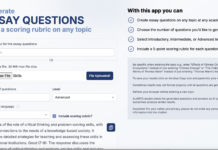 Di Xu & Shanna Smith Jaggars (2013) Adaptability to Online Learning: Differences Across Types of Students and Academic Subject Areas New York: Community College Research Center, Columbia University
Di Xu & Shanna Smith Jaggars (2013) Adaptability to Online Learning: Differences Across Types of Students and Academic Subject Areas New York: Community College Research Center, Columbia University
The study
Using a dataset containing nearly 500,000 courses taken by over 40,000 community and technical college students in Washington State, this study examines how well students adapt to the online environment in terms of their ability to persist and earn strong grades in online courses relative to their ability to do so in face-to-face courses.
The hypothesis
Some populations of students—for example, those with more extensive exposure to technology or those who have been taught skills in terms of time-management and self-directed learning—may adapt more readily to online learning than others. In addition, some academic subject areas may lend themselves to highquality online learning experiences more readily than others
The methodology
Primary analyses were performed on a dataset containing 51,017 degree-seeking students who initially enrolled in one of Washington State’s 34 community or technical colleges during the fall term of 2004. These first-time college students were tracked through the spring of 2009 for 19 quarters of enrollment, or approximately five years. The dataset, provided by the Washington State Board of Community and Technical Colleges (SBCTC), included information on student demographics, institutions attended, and transcript data on course enrollments and performance.
The results
- In descriptive terms, students’ average persistence rate across courses was 94.12 percent, with a noticeable gap between online courses (91.19 percent) and face-to-face courses (94.45 percent). For courses in which students persisted through to the end of the term (N = 469,287), the average grade was 2.95 (on a 4.0-point scale), also with a gap between online courses (2.77) and face-to-face courses (2.98).
- While all types of students in the study suffered decrements in performance in online courses, some struggled more than others to adapt: males, younger students, Black students, and students with lower grade point averages.
- Regardless of a particular student’s own adaptability to the online environment, her performance in an online course may suffer if her classmates adapt poorly. English and social science were two academic subjects that seemed to attract a high proportion of less-adaptable students, thereby introducing negative peer effects.
- Older students adapted more readily to online courses than did younger students.
- [Also] students who were more disposed to take online course also tended to have stronger overall academic performance than their peers
Comments
First, it is encouraging to see a detailed quantitative assessment of the types of students taking online courses, and their relative performance. This report needs to be read in full, and carefully. It is good that it is based on a significantly large enough sample that one can have confidence in the generalizability of the results (at least in the U.S. two-year college sector). The study was very well carried out and is a model for quantitative analysis of student differences.
Furthermore, I am not surprised or even concerned about these findings. For instance, from my own experience of online teaching, I would agree that ‘students are not homogeneous in their adaptability to the online delivery format and may therefore have substantially different outcomes for online learning.’ Online learning doesn’t suit everyone, and it is valuable to have some research that helps identify the more ‘at-risk’ online learners.
One can put forward a number of reasons why online students, on average, are likely to struggle compared with face-to-face students. Students who choose an online course are likely on average to have less time for study that those attending regularly on campus. Second, for many online students, the mode of study will be unfamiliar, which means making more adaptation to a different way of learning.
My one quibble is that, although the results are clearly significant statistically (as is almost inevitable in large samples), the differences are quite small (96% vs 91% completion rates, for instance.) Thus I do challenge the authors’ conclusion that ‘most students had difficulty adapting to the online context.’ If 91% complete the course, then most students did not have difficulties sufficient to deter them from completing successfully their courses. That seems a pretty good adaptation level to me.
I also have a concern that these results will be misinterpreted. This should not mean that men, Blacks and young people should be discouraged from taking online courses, but that we should be taking more care to ensure that students who do take online courses are better prepared, with particular attention being paid to those likely to be at most risk. This may mean, for instance, gradually introducing students to online learning in a deliberate way throughout a program. This study does suggest those most likely to be at risk.
Further reading
Lederman, D. (2013) Who benefits from online Ed? Inside Higher Education, February 25









 Dr. Tony Bates is the author of eleven books in the field of online learning and distance education. He has provided consulting services specializing in training in the planning and management of online learning and distance education, working with over 40 organizations in 25 countries. Tony is a Research Associate with Contact North | Contact Nord, Ontario’s Distance Education & Training Network.
Dr. Tony Bates is the author of eleven books in the field of online learning and distance education. He has provided consulting services specializing in training in the planning and management of online learning and distance education, working with over 40 organizations in 25 countries. Tony is a Research Associate with Contact North | Contact Nord, Ontario’s Distance Education & Training Network.


[…] Who benefits from online learning? […]
The online learning is the source of developing education. It helps to increase knowledge about learning education as well as latest updates regarding study. Students who are suffered from lower grades it helps to enhance their education level.